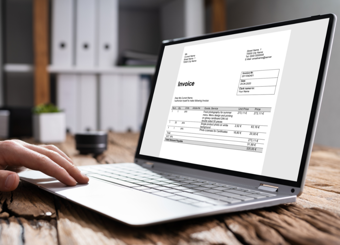How to improve working capital through Accounts Payable
While market trends change, one thing remains the same: cash is king! Companies focused on accessing financing externally may be overlooking a large, hidden source of capital - their own balance sheets. Working capital is the cash tied up in the everyday operations of a business. A company that keeps working capital down while satisfying business requirements can achieve higher returns on invested capital and more cash to fund future growth - a strategy that is more important than ever in light of the COVID-19 crisis.
Numerous ways exist to free up net working capital, including strategies around accounts receivable, accounts payable, inventory and cash management. Based on the Working Capital series of reports from Deloitte, a global financial advisory and consulting firm, this article summarizes how to improve working capital by using a strategic approach to help companies optimize working capital - and have more cash on hand.
Accounts Payable can increase working capital
Historically viewed as a pure back-office function, accounts payable is not known for taking center stage when businesses look to grow or build competitive advantage. But today accounts payable is often perceived as the spend management knowledge hub, the function that controls much of business-critical data that impacts the CFO agenda.
Establish your AP team as a key contributor to working capital optimization, particularly when working with the Procurement department, by taking the following steps:
- Centralize accounts payable processing and reporting - for example in a shared service environment. This approach ensures all staff members adhere to common standards and measure their performance against established business metrics - no matter where in the world they are accessing the data from.
- Automate processing and control communications with suppliers - with the goal to drive fully automated invoice processing. A common strategy includes implementing EDI (electronic data interchange). Businesses that automate their accounts payable systems by enabling electronic communication with vendors gain significant functionality advantages and savings through available discounts or rebates. Depending on the target level of AP automation, invoices can be scanned automatically, delivery receipts traced and disputes resolved electronically rather than through manual follow up. However, as Deloitte notes in their report, EDI technology is not for everyone.
- We agree EDI is only one technology that can provide detailed accounts payable information and ease communications with suppliers. But the key is not what technology companies use, but to make sure that the technology used can capture information in the process on a detailed level and give essential spend transparency to improve working capital.
- Advanced, modern and robust accounts payable automation solutions capture invoice information on an exact level (line-level) even from paper and PDF. They are not limited to electronic formats such as EDI and XML. To minimize time spent on manual communication with suppliers, ensure suppliers can track the status of orders, delivery schedules, potential product shortages and payments received, reducing manual interactions with the AP departments. Ways to do this include supplier portals or system automated e-mail notifications.
- Deploy robust governance practices and supporting workflows - that reduce the risk of manual error and strengthen internal controls around accounts payable automation. Processing workflows with clear approval structures help identify and resolve system bottlenecks and streamline process handoffs to improve liquidity management.
Smart strategies to free up cash and improve working capital
According to Deloitte, the accounts payable department can drive or support activities in six main processes that, if optimized, can free up cash and strengthen working capital. These processes are sourcing, master data, contractual reviews, procurement, invoicing, and accounting and reporting.
Link sourcing, master data and contractual reviews
Structured accounts payable data is the foundation of a successful strategic sourcing process. Without full spend transparency into buying behaviors, volumes and prices, critical steps in the vendor selection process will be challenging to perform. As part of the vendor selection process, there are several steps companies can take to negotiate terms designed to optimize net working capital such as:
- Negotiating longer payment terms, if you are coming from a strong position
- Negotiating volume or early payment discounts
Once companies have negotiated terms with vendors, it is essential to capture and maintain this data properly. Master data need to be synchronized between the ERP, procurement system and AP automation solution to attain true automation. Inaccurate entry of data can result in more than payment errors. It can lead to account delinquencies which prevent companies from taking advantage of available discounts and may even lead to disruptions in supply. Assigning responsibility for data to a central master data team can help streamline this process. Make sure to regularly review contracts and update payment terms and the availability of volume discounts, trade credits or other ongoing or periodic rebates.
Control the procurement process to manage cash flows
Some businesses work with hundreds or even thousands of suppliers. Even if the environment is more streamlined, it can be challenging to keep track of all the invoices received and reconcile each invoice to its associated PO. Failure to accurately manage payables makes it harder to forecast and manage cash flows and anticipate short-term liquidity needs.
Without a sourcing and procurement process flow, businesses risk overspending or trading with unapproved suppliers. The strategies below can help companies achieve internal compliance:
- Issue POs for each new order to validate any orders received, lock in payment terms in advance and track invoices against existing POs to ensure suppliers bill per the agreed-upon terms
- Make sure your AP automation solution can capture detailed invoice information from non-PO invoices to maintain spend transparency
- Maximize savings potential by exploring early payment discounts, volume rebates or trade spend initiatives. Keep in mind that you don’t need to accept all early payment discounts. If you don’t have the cash on hand or the capital outlay exceeds the benefit of the discount offered, it may make sense to pay later
- Track payables outstanding by the vendor and by payment terms
- Set clear accounts payable metrics (such as frequency of invoices that match POs, the percentage of invoices paid to terms and percentage of negotiated discounts captured) and adhere to them across the organization.
Create transparency in the invoice and reporting process to improve liquidity
Properly managing the invoicing process is another way to improve liquidity. Paying invoices only when they are due will improve cash flow but may have the disadvantage of losing early payment discounts. Access to financial data in real-time also helps management detect opportunities to take advantage of money-saving tax incentives.
Before companies can actively manage payables, they need to ensure that accounting reports are up-to-date and financial records fairly reflect current accounts payable balances. Without this data, many businesses lack visibility into how much, how often and when they pay their suppliers. This situation can limit them to choose the most advantageous payment terms or select appropriate timing in which to pay vendors. Make sure that your company has real-time reporting capabilities by automating reconciliations and ensuring they remain current. Use real-time updates to instantly resolve disputes with customers and vendors, manage inventory and analyze fixed and variable costs.
Cross-functional collaboration is the key to success
To effectively identify these opportunities, businesses must take a more strategic approach to accounts payable. The AP team, along with the purchasing and procurement departments, should collaborate with senior management to inject a working capital culture throughout the company. This approach is about more than ensuring invoices are received and processed in a timely fashion. It’s about adopting a management focus that emphasizes the importance of optimizing payables and freeing up net working capital to fuel growth. Communication, education and AP automation are cornerstones to learning how to improve working capital with a strategic approach to accounts payable.






